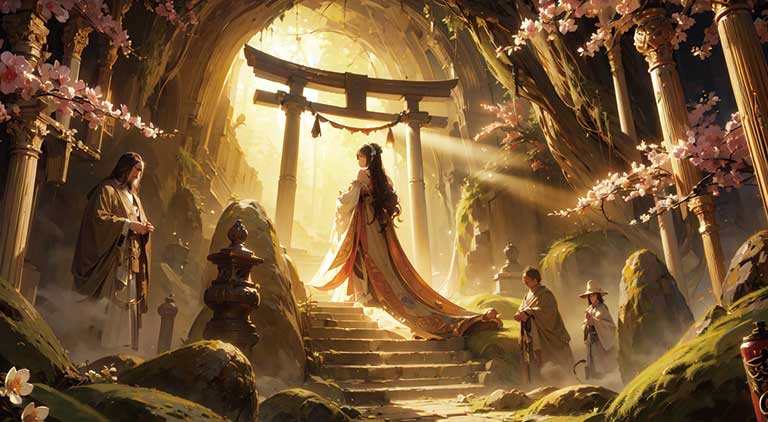The Amano-Iwato Legend is one of the most symbolic episodes in Japanese mythology, illustrating the eternal struggle between light and darkness, order and chaos. This myth not only underpins ancient Japanese religious rituals and festivals but also continues to inspire modern cultural expressions.
Background of the Legend
Amaterasu and Her Divine Role
Amaterasu, the radiant sun goddess, is revered as the source of light, life, and order. As the ruler of the heavenly realm, her divine authority has been central to Japan’s national identity and the legitimization of its imperial lineage. However, even a goddess of such immense power is not immune to the conflicts that arise among the divine.
The Conflict with Susanoo
The origins of the Amano-Iwato Legend lie in the turbulent relationship between Amaterasu and her brother, Susanoo. Known for his destructive actions and unruly behavior, Susanoo’s transgressions deeply disturbed the harmony of the divine realm. His behavior ultimately provoked Amaterasu’s profound anger and sorrow, setting the stage for one of the most dramatic episodes in Japanese mythology.
The Key Episodes of the Amano-Iwato Legend
Amaterasu’s Retreat into the Cave
Overwhelmed by the chaos wrought by Susanoo, Amaterasu withdrew from the world and secluded herself in a cave known as Amano-Iwato. Her self-imposed isolation plunged the cosmos into darkness, as the life-giving rays of the sun disappeared. The absence of light ushered in a period of despair and confusion for both gods and humans alike.
The Gods’ Determined Effort
Faced with the catastrophic loss of light, the other deities were determined to restore balance to the universe. Recognizing the dire consequences of Amaterasu’s seclusion, they devised a clever plan to coax her out of the cave. Central to this plan was the role of the goddess Ame-no-Uzume, whose actions would prove to be a turning point in the legend.
Ame-no-Uzume’s Dance and the Triumph of Laughter
In an effort to break the gloom that had taken hold, Ame-no-Uzume performed a spirited dance before the cave’s entrance. Her infectious laughter and exuberant movements not only captivated the assembled gods but also reached the heart of the secluded Amaterasu. Overcome by curiosity and the stirring sound of mirth, Amaterasu peered out from the cave, allowing a sliver of sunlight to break through.
The Restoration of Light
Seizing the moment, the gods rallied together to fully open the cave. As the barrier was lifted, the lost sunlight returned, banishing the darkness and restoring balance to the world. This dramatic reemergence of Amaterasu underscored the enduring power of unity and the triumph of light over darkness.
Symbolic Significance and Cultural Impact
Duality of Light and Darkness
The Amano-Iwato Legend is a profound illustration of duality: the interplay between light and darkness, and the eternal contest between order and chaos. Amaterasu’s retreat and eventual return symbolize not only the cyclical nature of existence but also the hope that even in our darkest moments, renewal is possible.
Social and Religious Influences
Far beyond a simple myth, the Amano-Iwato Legend has shaped religious practices and cultural traditions throughout Japan. It plays a central role in Shinto rituals and festivals, reinforcing community bonds and the continuity of ancient traditions. The story serves as a reminder of the resilience inherent in both the natural and spiritual worlds.
Modern Cultural Resonance
Today, the legacy of the Amano-Iwato Legend permeates various forms of modern media—from anime and films to literature and art. Its timeless themes continue to captivate creators and audiences alike, offering rich metaphors for exploring themes of renewal, unity, and the perpetual balance between opposing forces.
Conclusion
The Amano-Iwato Legend is more than just a myth—it is a timeless narrative that encapsulates the struggle and eventual triumph of light over darkness. Through the dramatic episode of Amaterasu’s seclusion and the ingenious efforts of the gods, this legend teaches us about the power of resilience, unity, and hope. Whether examined through a historical, cultural, or modern artistic lens, the tale of Amano-Iwato remains a compelling testament to the enduring power of myth in shaping human understanding of the world.
- Amaterasu – Japan’s Sun Goddess: The Heart of Japanese Mythology
- source: Wikipedia – 天照大神


Comments